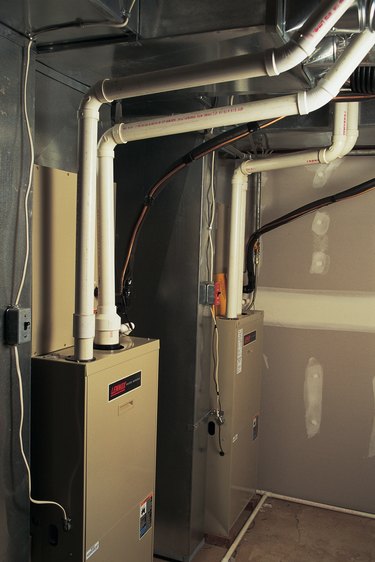
Limit switches are found on all types of furnaces, whether they run on oil, gas or electricity. The primary limit switch is a temperature-activated sensor that protects your furnace from overheating whenever the fan fails to blow enough air over the heat exchanger. The limit switch also controls when the blower assembly turns on and off.
Safety Devices
Video of the Day
If the blower fan didn't turn on when the furnace ran, the heat exchanger would overheat and crack or warp. Cracked heat exchangers can be dangerous because they allow carbon monoxide to leak into your house. By turning off the burner when the temperature in the plenum rises too high, the primary limit switch functions as a safety device.
Video of the Day
Operation
The limit switch also tells the blower assembly when to turn on and off. A bi-metallic spring in the limit switch is inserted into the plenum, which is located above or next to the heat exchanger. This spring expands when the air in the plenum warms up, and moves the gear that turns the fan limit control dial. The rotating control dial manipulates the contacts inside the switch that are responsible for turning the fan on and off.
Air Flow
Anything that restricts the flow of air over the heat exchanger can cause the primary limit switch to trip and turn off the main burners. Dirty air filters or blocked or damaged air ducts are two common problems. Inspect your air filter every month during the heating season and change it, if necessary. Inspect ductwork for kinks, crushing or other damage. Another reason the limit switch might trip is if you close more than 60 percent of your registers. Closing too many registers makes it hard for the furnace to distribute all the heat it produces, and could cause it to overheat.
Testing
Turn off the electricity to your furnace before you test the primary limit switch, and wait about 10 minutes to give it time to cool down. Remove the wires from the switch's terminals and use an ohmmeter to test each terminal for continuity. Lack of continuity indicates a defective switch. You can also test the limit switch with a digital voltmeter. Attach the voltmeter across the two connections of the limit switch while the furnace is operating. The voltage drop should be no more than 0.1 VDC. If the voltage drop is 0.2 VDC or more, the switch is definitely bad. Replace the limit switch with an identical part that has the same setting and style limits. Never use a limit with a higher setting than the one originally installed in the furnace.
- InspectAPedia: Guide to Combination Fan & Limit Switches on Warm Air Furnace Heating Systems
- Dinosaur Electronics: Limit Switch Testing
- HVAC Tech Support: Furnace Troubleshooting
- B&E Air and Heat: The Dangers of a Cracked Heat Exchanger are Real
- 24 Hour Heating and Air Conditioning News: 4 Common Furnace Mistakes: Registers
- Nordyne E2 Series Electric Furnace Service Manual
- Arnold Service: Troubleshooting Heating Problems